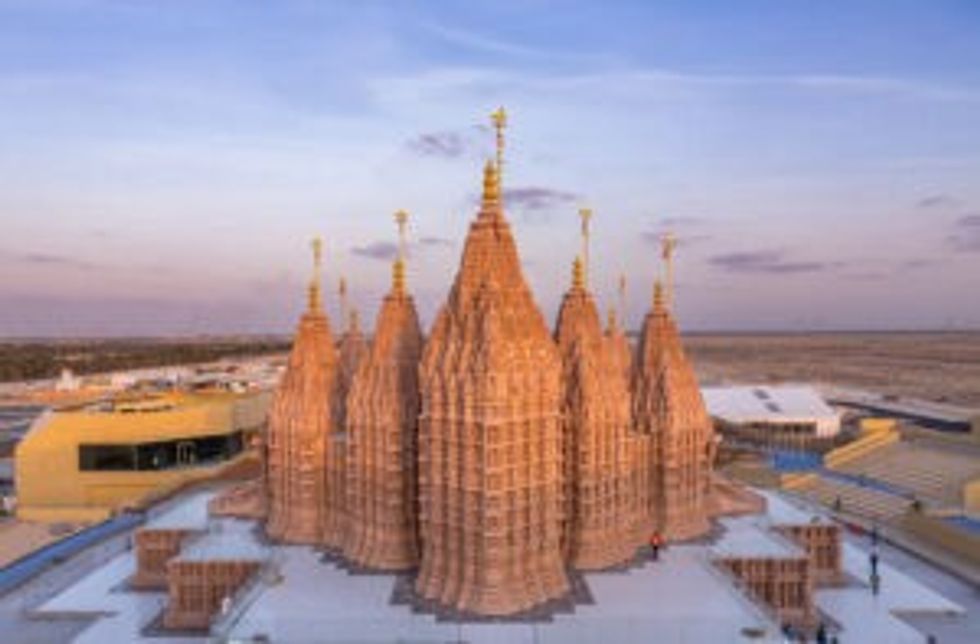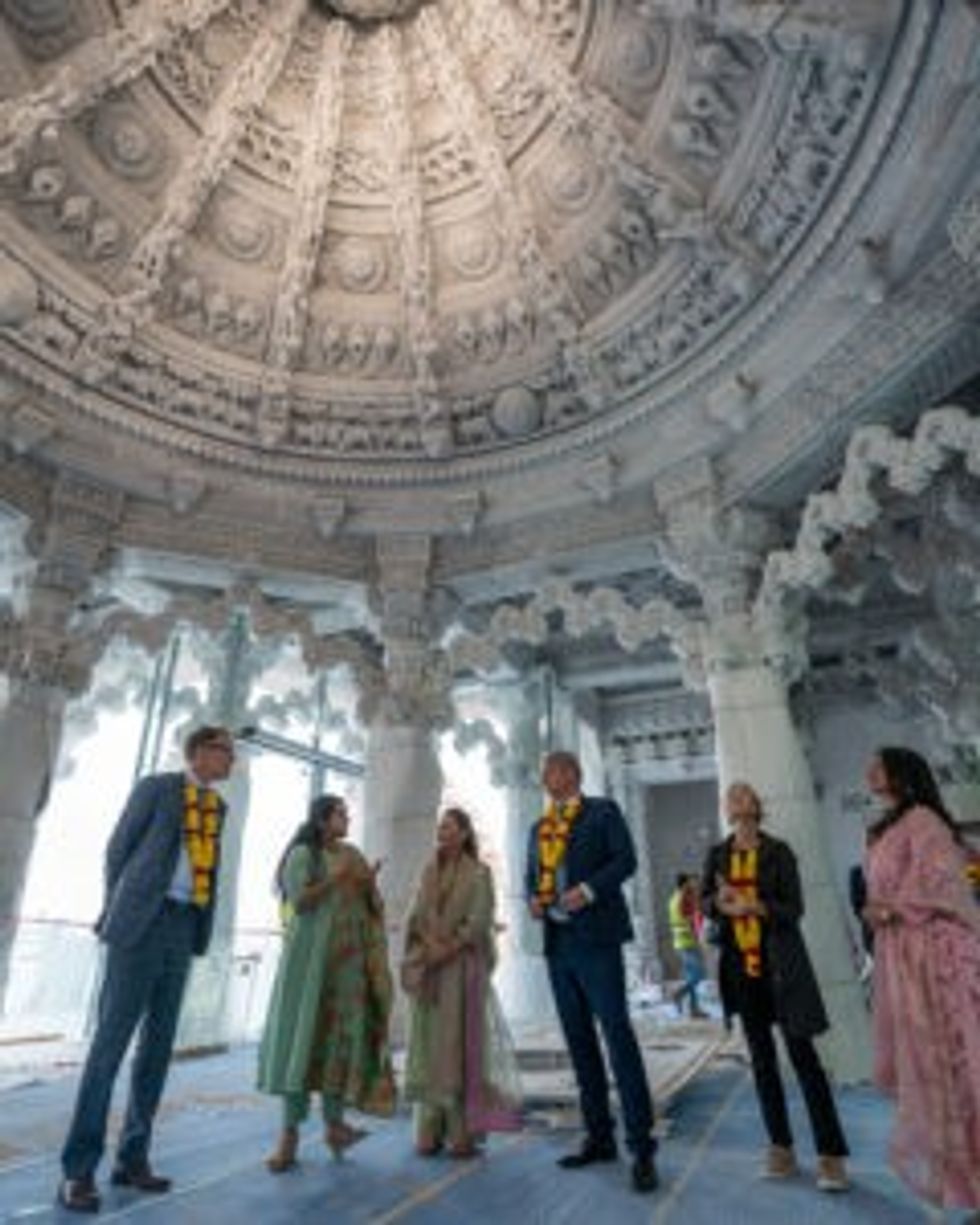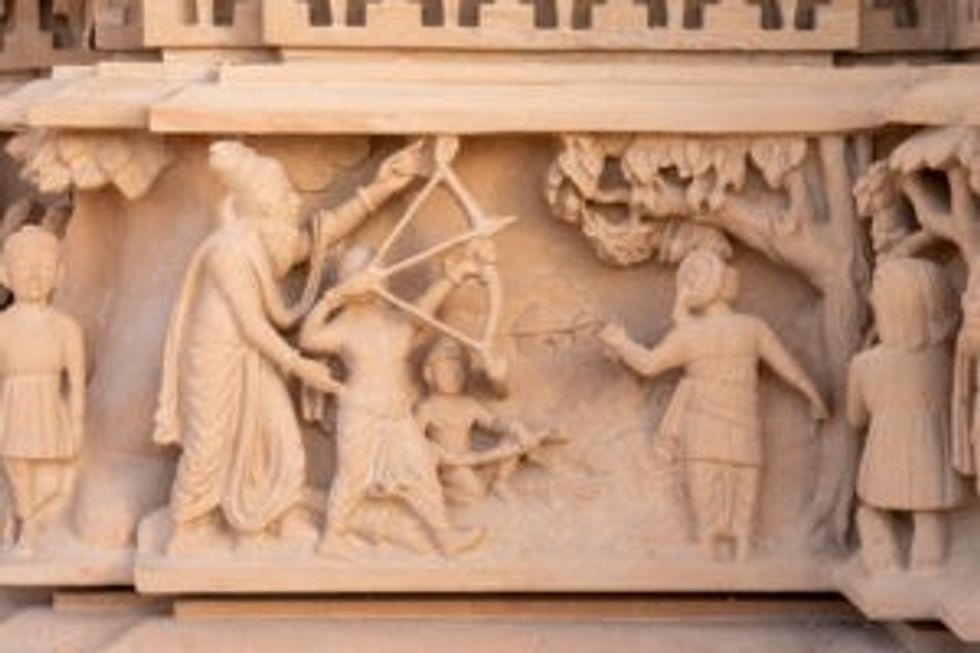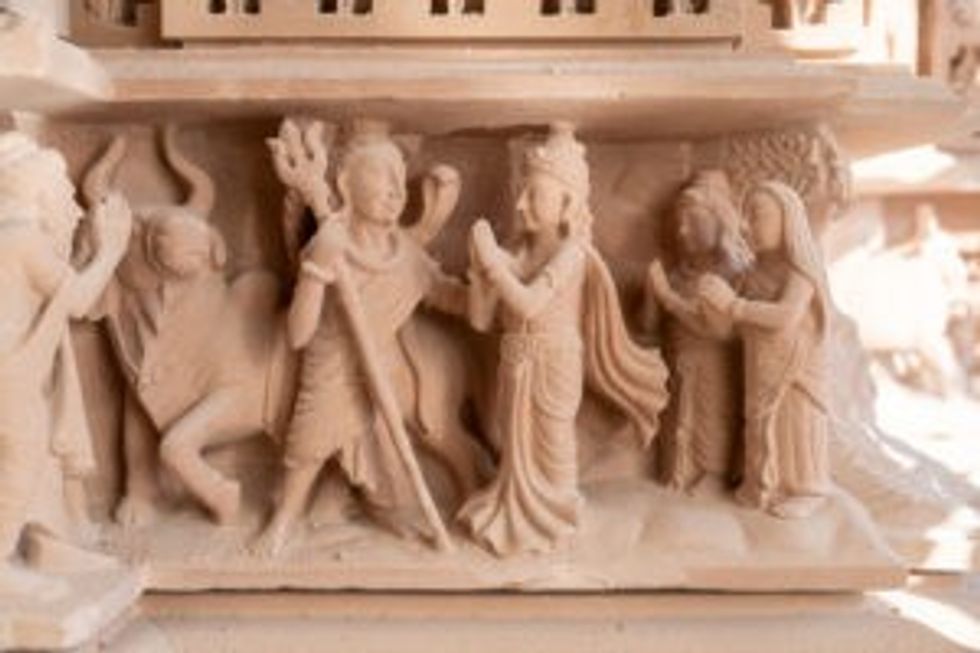THE Bochasanwasi Shri Akshar Purushottam Swaminarayan Sanstha (BAPS) Hindu Mandir in Abu Dhabi, UAE, is envisioned as a Spiritual Oasis for Global Harmony.
Rooted in the aspiration to promote love, harmony, and tolerance, the fundamental ethos of the mandir transcends borders. Each carving within the mandir tells compelling stories of harmony and spirituality, drawing inspiration from ancient Indian scriptures to emphasise peace. Actively contributing to the UAE’s mission of happiness and harmony, the mandir fosters love, tolerance, understanding, and peaceful coexistence.
“The Abu Dhabi temple not only stands out for its distinctive architecture and grandeur but also conveys a profound message of ‘Vasudhaiva Kutumbakam’ (the world is one) to people worldwide,” remarked Indian prime minister Narendra Modi.
This exemplifies harmony a piece of land bestowed by a Muslim ruler, a project envisioned by a Catholic Christian. Inspired by HH Pramukh Swami Maharaj and blessed by HH Mahant Swami Maharaj, the mandir seamlessly integrates traditional Hindu elements within a fully operational, multifaceted complex embracing social, cultural, and spiritual dimensions. The idols within hail from diverse corners of India North, South, West, and East.
“It presents a unique opportunity, not just to preserve ancient art and architecture but also to forge a new legacy lasting for thousands of years,” said HH Sheikh Abdullah bin Zayed Al Nahyan, the UAE’s Minister of Foreign Affairs and International Cooperation. “This ambitious project of global harmony aims to rejuvenate faith and hope, celebrating the exceptional friendship between India and the UAE and their shared commitment to progress and peace,” Al Nahyan added.
Accommodating 8,000 to 10,000 people, the mandir is open to individuals of all beliefs, backgrounds, races, and religions.
A desert prayer materialises
On April 5, 1997, Pujya Pramukh Swami Maharaj embarked on a visit to the UAE. Eager to share their surroundings, the UAE BAPS team took him on a desert ride to Al Khawaneej. As they reached the site, a gusty wind swept sand into their eyes, rendering conversation impossible. Seizing the moment, Swami Maharaj prompted them to contemplate the challenges faced by the Arabs in the unforgiving desert.
Seated amidst the desert expanse, Pujya Pramukh Swami Maharaj uttered a prayer: “May peace prevail here and everywhere. May all countries be free of internal enmity and prejudice to wards each other.”
Then, in a poignant culmination, Swami Maharaj added, “May there be a mandir in Abu Dhabi.” These words, spoken in that timeless moment, have since transformed into a prophetic and divine prayer, echoing the remarkable journey of its fulfilment.
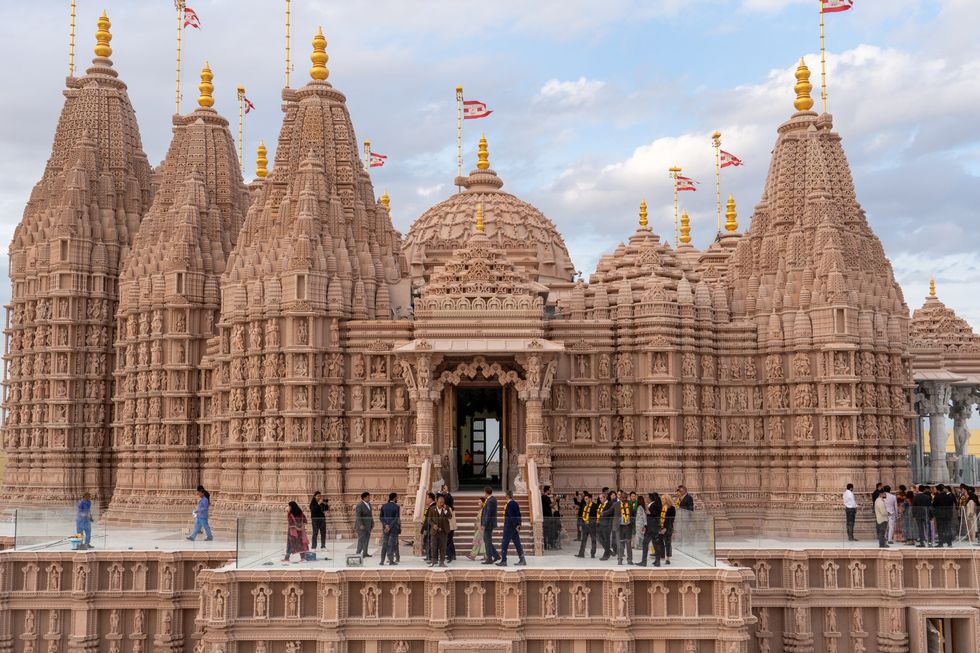
Over the years, BAPS devotees engaged with community and government leaders to secure permission for land to build the mandir. In August 2015, the UAE government allocated land for the temple in Abu Dhabi. HH Sheikh Mohamed bin Zayed Al Nahyan, the then Crown Prince of Abu Dhabi, generously gifted the land during Indian prime minister Narendra Modi’s official visit to the UAE. Following the signing of eight MoUs between Prime Minister Modi and the Crown Prince, the Mandir was officially announced at the Presidential Palace as a Golden Amrut Kalash, in the presence of BAPS sadhus.
Pujya Pramukh Swami Maharaj left his mortal remains in August 2016, having witnessed the UAE government’s green light for the mandir. And, this development holds particular significance in the Middle East, serving as a noteworthy example that embodies the values championed by Pujya Pramukh Swami Maharaj. The temple’s presence will undoubtedly contribute to the spread of these values, reflecting a profound impact on the region and beyond.
Sheikh Mohamed’s generosity
BAPS representatives found themselves at the presidential palace during Indian prime minister Modi’s second visit to the UAE in 2018, where an unforgettable day unfolded, marked by the firsthand experience of Sheikh Mohamed’s generosity. In a crucial meeting, two plans were presented to Sheikh Mohamed and the Indian prime minister, leaving the fate of the mandir in suspense. The first plan proposed a conventional temple design, with deity images housed inside for worship, akin to a Hari mandir. The alternative suggested creating a breath-taking traditional stone mandir, encapsulating 10,000 years of Indian art and culture. With characteristic generosity, Sheikh Mohamed chose the latter, marking a historic moment as the first such mandir in the annals of human civilization.
Initially, the UAE government allocated 13.5 acres (5.5 hectares, or 55,000 square metres) for the temple, later supplemented by an additional 13.5 acres for parking space. The UAE government foresaw that the mandir would transcend its role as a mere temple, bringing countries, communities, and people closer together.
Indian foreign minister Dr S Jaishankar, reflecting on the temple’s construction, described it as a tale of “heart and mind.”
In an address, he acknowledged the Abu Dhabi temple as a miraculous story, attributing its realisation to the convergence of dreams and predictions by Pujya Pramukh Swami Maharaj, underlining the generosity of kings that played a pivotal role in its manifestation.
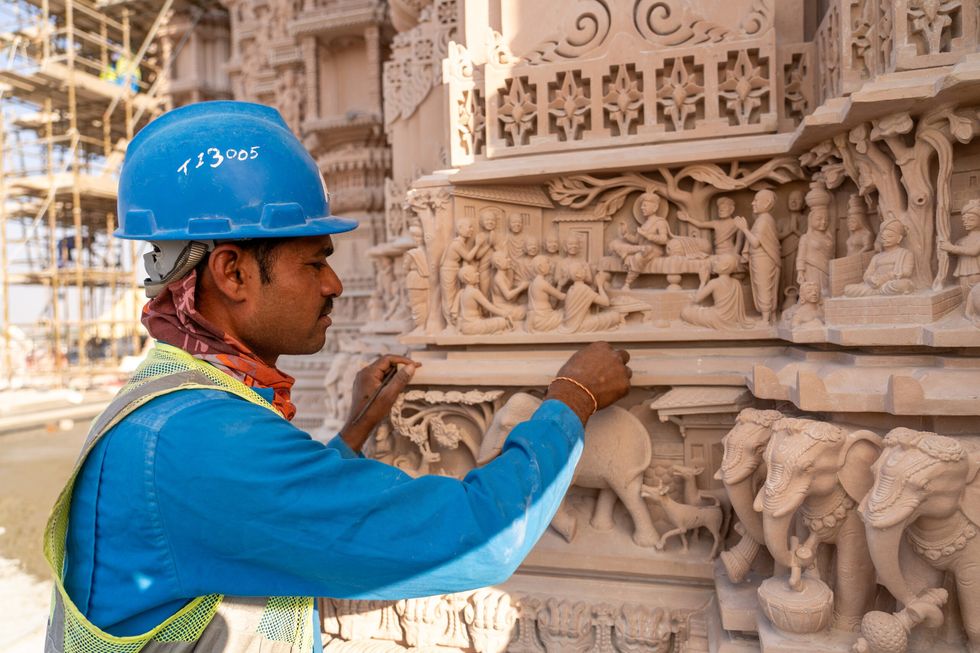
The Abu Dhabi mandir stands as a “historic milestone” in the bilateral relationship between the UAE and India. Notably, the UAE holds a unique position as the only country in the world with a Ministry of Tolerance. The realisation of this significant achievement is underpinned by the mutual respect for these values. This shared commitment to tolerance and understanding has paved the way for this remarkable milestone.
The first traditional Hindu temple
Situated in the Abu Mureikha area near Al Rahba off the Dubai–Abu Dhabi Sheikh Zayed Highway, the Abu Dhabi mandir stands as inaugural traditional Hindu stone temple in Middle East. Inspired by the Akshardham Mandir in Delhi and another BAPS Mandir in New Jersey, this architectural marvel is a testament to timeless craftsmanship, with BAPS investing over 400 million dirham (£85.88m) to complete its construction.
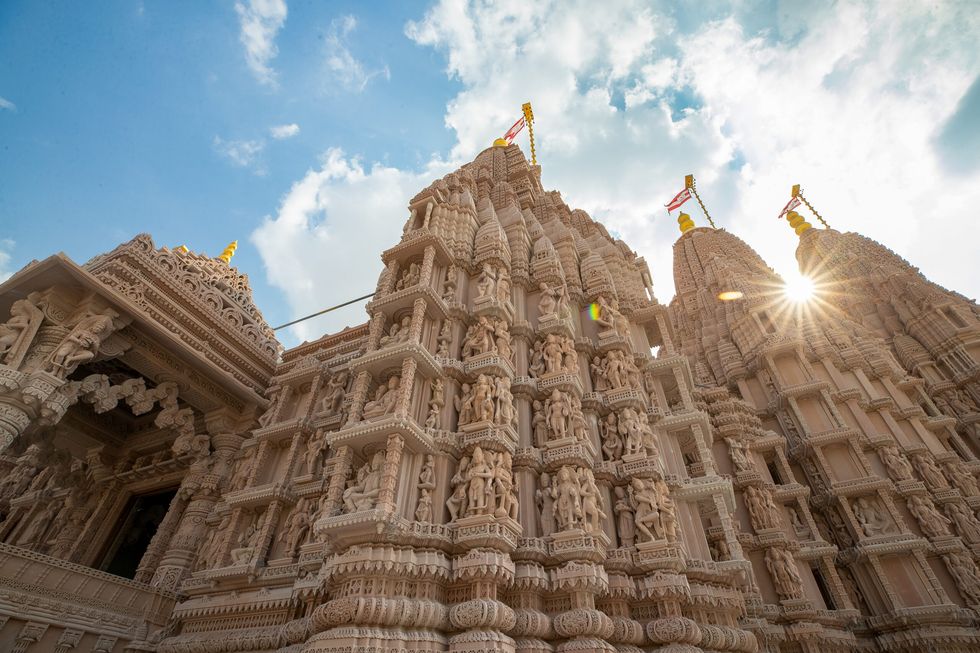
The first Hindu temple in Dubai, established in 1958, faithfully served the Hindu and Sikh communities for decades. In 2012, HH Sheikh Mohammed bin Rashid, Vice President of the UAE and Ruler of Dubai, granted land for the UAE’s first gurdwara. Now, the Abu Dhabi mandir is the third major Hindu place of worship in the country and the first in the capital.
This mandir symbolises the enduring relationship between India and the UAE, with its seven spires honouring the seven emirates—Abu Dhabi, Dubai, Sharjah, Ajman, Umm Al-Quwain, Ras Al Khaimah, and Fujairah. Meticulously adhering to the ancient Hindu shilpa shastras, Sanskrit scriptures dictating architectural principles, the temple embodies co-existence and tolerance championed by HH Sheikh Zayed bin Sultan Al Nahyan, the country’s founding father.
In a landscape where grand mosques and churches harmoniously coexist, the mandir stands as another beautiful monument. Laid in the Year of Zayed (2018 marked the 100th birthday of HH Sheikh Zayed bin Sultan Al Nahyan, the founder of the UAE), the mandir adds a poignant touch to this symbol of unity.
‘Lotus in the desert’
Pujya Mahant Swami Maharaj described the temple as a lotus that has blossomed in the desert.
“The temple being built in Abu Dhabi is truly a miracle. It is only happening due to God’s wish; it would not happen otherwise. The Arabs are very intelligent. They put their minds to it, and this is how this has happened,” said Pujya Mahant Swami Maharaj at the BAPS Swaminarayan Mandir in Robbinsville, New Jersey, U.S.
“In a very beautiful desert land, the temple is like a lotus blossoming in the sand. The temple is being built just like that,” Pujya Mahant Swami Maharaj added.
Behind the scenes, the visionary leadership of Swami Brahmaviharidas guided the construction, ensuring every detail reflected spiritual grandeur. Overseeing the meticulous realisation of this architectural marvel, Swami Akshaymunidas contributed his expertise to bring the temple to fruition, creating a haven where beauty and divinity coalesce in a harmonious celebration.
The temple stands as a testament to the profound influence of ancient Hindu architectural principles, meticulously crafted in accordance with the revered shilpa shastras – Sanskrit scriptures dedicated to the art of architecture and sculpture. Within its sacred walls, a breath-taking array of hand-carved sculptures unfurls, each narrating a vivid tale that intertwines the rich history and culture of India.
Intricately designed symbols, including the regal presence of camels, seamlessly blend Arab influences with the timeless artistry of the subcontinent. Marvel at the exquisite depictions of pivotal moments from Indian epics such as the Ramayana, Mahabharata, and various narratives drawn from Hindu scriptures and mythology, etched in stone with unparalleled skill.
Forged from 9,000 tonnes of pink sandstone delicately transported from Rajasthan, India, the mandir transcends being merely a structure; it unfolds as a sanctuary embracing educational facilities, tranquil gardens, and the central murti mandir. Dressed in 28,000 hand-carved murtis (deities) and intricate stonework, the sanctum sanctorum stands tall—a living testament to the profound artistry woven into the fabric of India’s cultural heritage.
Additionally, 14 value tales spanning the Arabic region, China, Aztec civilisation, and Mesopotamia illustrate the universal theme of love that transcends cultural boundaries.
Adding a divine allure to the ambiance are the idols of revered Hindu deities: the eternal love of Radha-Krishna, the virtuous duo of Ram-Sita accompanied by the devoted Hanuman, the divine union of Shiv-Parvati, the valorous Kartikeya, and the benevolent Ganesh and Ayyappa, alongside the timeless Akshar and Purushottam.
Upon entering the temple, visitors will be greeted by two streams of water that symbolises the sacred Ganga and Yamuna rivers. A radiant beam of light, representing the mythical Sarasvati river, will gracefully traverse beneath the structure of the temple.
Nagarshaili architecture
This mandir is a distinctive addition to the UAE’s architectural landscape, seamlessly blending into the vibrant tapestry where traditional, weathered stone structures coexist harmoniously with sleek, modern edifices. Together, they weave a compelling narrative of design, purpose, and cultural evolution.
Adhering faithfully to the traditional Nagarshaili architectural style, the mandir emerges as a masterpiece following the guiding principles of the shilpa shastras.
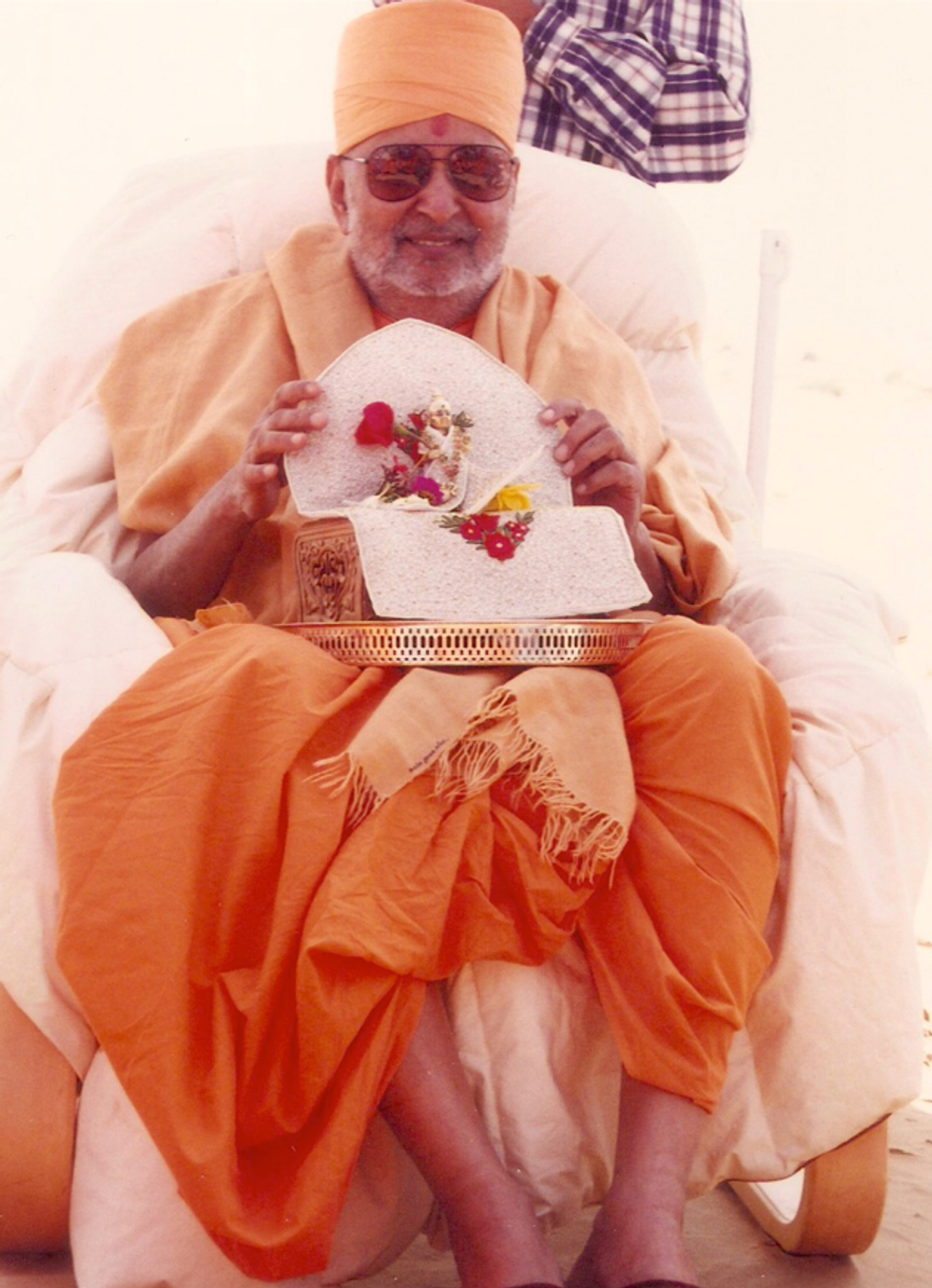
Its facade serves as a canvas, proudly adorned with life-sized panels depicting universal values, narratives of harmony from diverse cultures, and representations of revered spiritual leaders and avatars from the Hindu tradition.
The shikhar (spire) of each shrine intricately weaves the life stories of resident deities through meticulously carved details, showcasing the skilled craftsmanship that defines this remarkable Mandir. With seven spires, two prominently raised domes, and a dedicated Nilkanth Varni Abhishek area designed for the ritualistic abhishek of the murti, the temple stands as a testament to both architectural brilliance and spiritual devotion.
Within its sacred precincts, two ritual rooms offer spaces for individuals to conduct personal rites and participate in mahapuja ceremonies. The mandir’s intricate stone carvings, a labour of love by more than 4,000 skilled sculptors from Rajasthan, were meticulously prepared in India. Now, the collaborative efforts of 150 heritage craftsmen have converged to bring this vision to life, engineering the mandir with unwavering dedication and expertise.
Nature’s tapestry
The mandir’s architecture intricately intertwines arches, pillars, and domes adorned with captivating motifs of peacocks, elephants, trees, and flowers, extending a warm welcome to all who enter. This thematic celebration of nature aligns with a universal pattern observed in other temples under the auspices of BAPS.
Among the standout designs is the Mayur Dwar, or peacock gate, a distinctive feature shared by both the Delhi and Robbinsville temples. Upon stepping inside, the interior unfolds with intricate carvings depicting Hindu deities and saints. Ornate pillars grace the space, adorned with figurines of devotees playing small drums or classical string instruments like the sarod and sitar. Other sections showcase gold-coloured metal sculptures of revered sages.
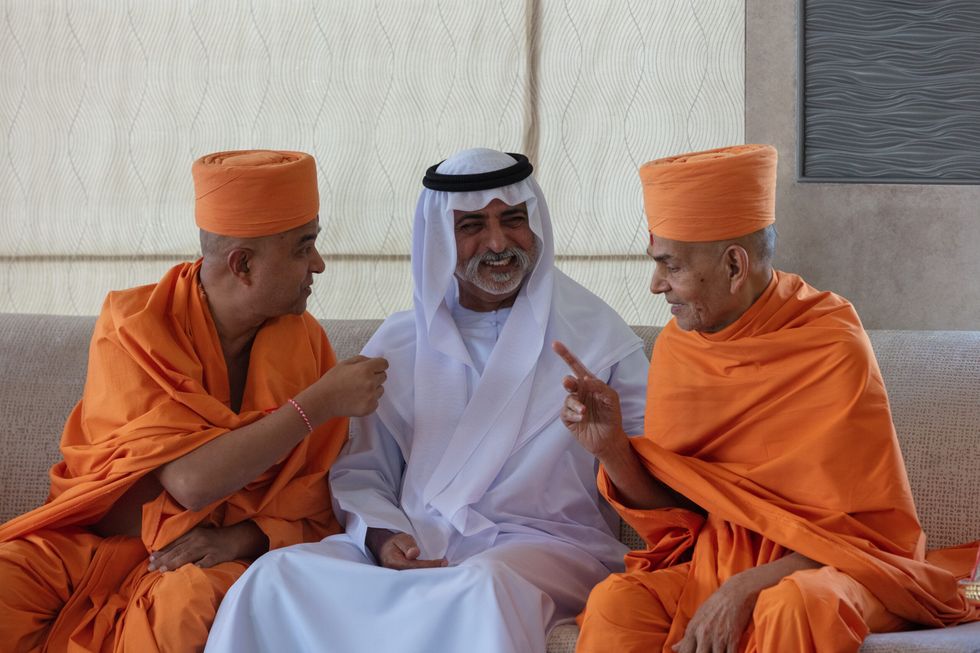
A unique design element captures models of elephants engaged in labour, carrying heavy logs of wood or lifting garlands of flowers with grace. These engravings unfold narratives of wisdom and devotion, contributing to the temple’s rich tapestry of symbolism.
Notably, the absence of machine work underscores the meticulous craftsmanship involved in the creation of these temples. From the Mayur Dwar to the detailed engravings, each element carries its own narrative. Regardless of one’s religious affiliation or beliefs, a visit to these temples promises a profound sense of peace and serenity, encapsulated in the artistry and spirituality embodied within their walls.
The ornate hand carvings on the exterior of the mandir and its pillars also incorporate local features from the UAE, further enhancing the temple’s connection with its surroundings.
The Rajasthan touch
The mandir’s exquisite panels of marble and stone bear the imprint of meticulous craftsmanship, skilfully shaped by artisans in Pindvada, Sikandra, and various rural workshops across Rajasthan, India. These intricately crafted elements were then thoughtfully transported to Abu Dhabi, where they were assembled, fusing the artistic essence of Indian craftsmanship with the heart of the UAE. The selection of durable stones from northern India was a strategic choice, ensuring their resilience in the face of scorching summer temperatures that can soar up to 50°C, a common occurrence in the UAE.
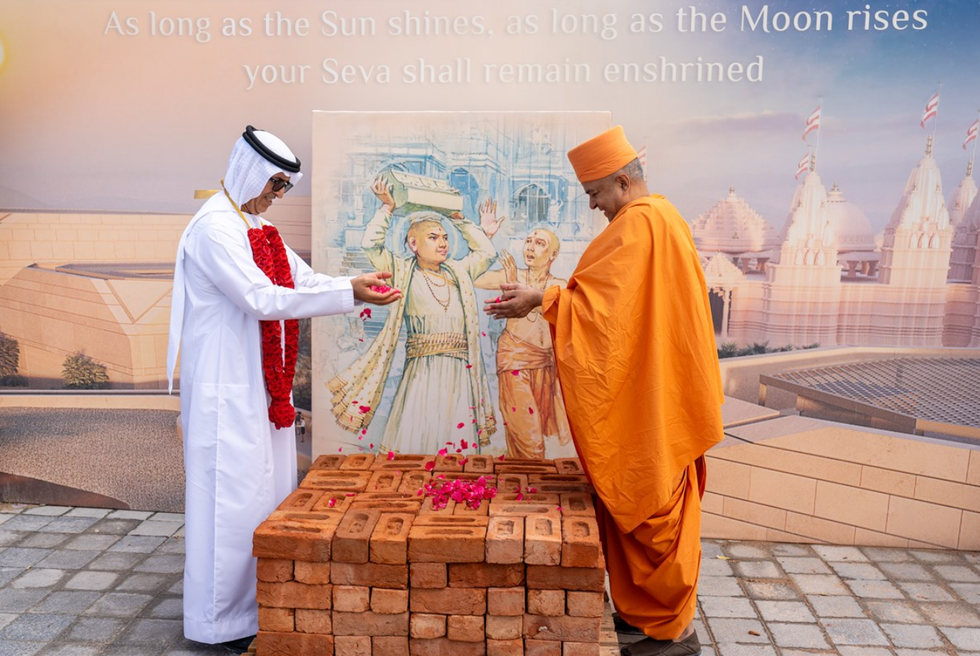
The selection process itself is a testament to precision, involving the careful curation of pink sandstone from premier quarries in Rajasthan and white marble sourced from Italy—chosen as the primary stones for the mandir. These stones undergo a journey of intricate carving at designated sites in Gujarat, Rajasthan, and Orissa, skilfully executed by heritage artisans with generations of expertise.
The chosen materials for stone construction encompass pink sandstone from Rajasthan quarries and white marble imported from Italy. To further enhance structural integrity and mitigate the risk of cracks, the incorporation of bamboo and glass elements becomes pivotal, adding both strength and visual appeal to the mandir’s grand design. This meticulous attention to materials and craftsmanship weaves a narrative of dedication, blending the rich heritage of India with the architectural vision of the UAE.
Sustainability measures
In 2020, the BAPS Hindu Mandir achieved a significant milestone with a ceremony commemorating the pouring of 3,000 cubic metres of a unique concrete mix for its foundation. This distinctive blend, comprising 55 per cent fly ash, stands out for its environmentally conscious approach, significantly reducing the construction’s carbon footprint compared to conventional concrete mixes commonly used in the region.
The construction of the temple deliberately avoided the use of steel or any ferrous materials, emphasising a commitment to traditional building techniques and materials.
Of particular significance is the adherence to traditional principles of ancient stone architecture, as these foundations eschew steel reinforcement – a departure from the norm in religious stone structures in India. This event represented the largest single pour of its kind in the UAE, symbolising a ground-breaking moment in sustainable construction practices.
Implementing ancient Indian technology, the foundation incorporates fundamental natural elements like bamboo, earthen clay bricks, and stone. To counterbalance the inherent lack of tensile strength in concrete, predominantly possessing compressive strength, bamboo and glass are strategically integrated vertically within the foundation. This thoughtful inclusion serves to prevent the development of cracks in the transversal direction, ensuring the structural integrity of the mandir and highlighting its commitment to eco-friendly construction practices.
Furthermore, in a concerted effort to minimise waste, any remaining wooden pallets and stone will be repurposed into furniture and fittings. This commitment ensures that all materials obtained for construction are conserved in an environmentally responsible manner, underscoring the mandir’s dedication to sustainable practices from foundation to finishing touches.
Blending ancient wisdom with modern science
The stones, meticulously assembled, employ a time-honoured lock-and-key method deeply ingrained in the traditional construction of ancient Indian mandirs for centuries. This unique technique relies on shear gravitational load rather than adhesive, ensuring the mandir’s structural integrity. Notably, the absence of rebar or any other reinforcement emphasises its status as a pure stone structure, embodying the authenticity of traditional construction methods.
Beyond its traditional roots, the mandir stands as an innovative stone structure, incorporating over 300 temperature, load, and strain sensors strategically positioned across 10 distinct levels within the foundation. These sensors are ingeniously designed to continuously collect and transmit real-time data on stress, pressure, and temperature measurements.
This forward-thinking approach sets a precedent for ongoing monitoring and analysis over the next 50 years, establishing a remarkable standard for continuous surveillance and evaluation of the mandir’s structural health.
All in one
The BAPS Hindu Mandir complex is set to be an exceptional achievement in ancient Indian architecture, destined to become a focal point for art, culture, and values. Here’s a glimpse into the diverse offerings within its expansive grounds:
Visitor centre: Immerse yourself in an exhibition that encapsulates the theme of ‘Vasudhaiva Kutumbakam,’ an ancient Vedic mantra. This poignant representation emphasises the urgent need for and the pathway to harmony.
Multipurpose hall: A dedicated space for individuals to practice their faith and engage in spiritual dialogues, fostering an understanding of life’s values and spirituality.
Prayer halls: These halls provide a sacred space for community members to practice and observe their religious beliefs.
Library: A repository promoting universal values of peace, spirituality, and global inclusiveness. With its collection of articles, books, and publications, the library aims to inspire virtuous living.
Classrooms: Offering cultural and spiritual education to people of all ages, with a special emphasis on providing basic English, accounting, and other educational opportunities for the lower echelons of society.
Thematic gardens: Reflecting ideas that promote and enhance spirituality and culture, these gardens create a serene environment.
The three rivers: Symbolically representing Ganga, Yamuna, and Sarasvati, these rivers surround the mandir complex. The mandir stands at their convergence point, embodying an oasis of spirituality and serving as a guiding light for global harmony.
Food court: A designated area providing visitors with vegetarian dining options during their visit to the mandir.
Book and gift shop: A space offering a variety of books and gifts, would enhancing the spiritual experience of visitors.
Amphitheater: Overlooking the central shrines of the mandir, this venue will be utilised for thematic shows and cultural performances.
Community development centre: Serving the purpose of mediating harmony within families, this centre would be a hub for community-building initiatives.
Together, these elements weave a tapestry of cultural richness, spiritual growth, and community engagement within the BAPS Hindu Mandir complex.
‘Message of harmony’
“This sacred space, now and for centuries to come, carries a singular message – one of harmony,” said Swami Brahmviharidas, who led the UAE mandir project.
“Whether fostering unity within families, establishing harmony with oneself and with God, or promoting unity among nations and religions, that is the sole message it should convey.”
“Aligned with the essence of Indian culture and Hinduism, rooted in the belief of interconnectedness and coexistence, harmony is not a foreign concept; it’s inherent in our relationship with nature – the sun, moon, forests, and waters – elements we worship. The primary resonance from this place should be global harmony, starting with individual harmony.”

